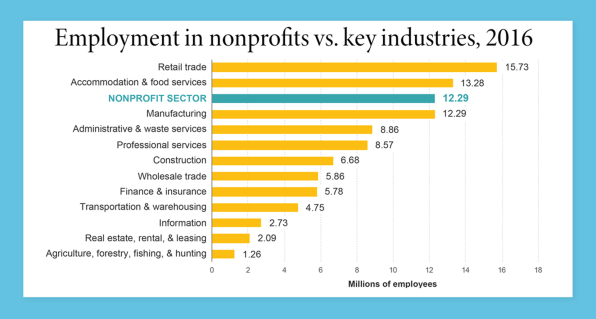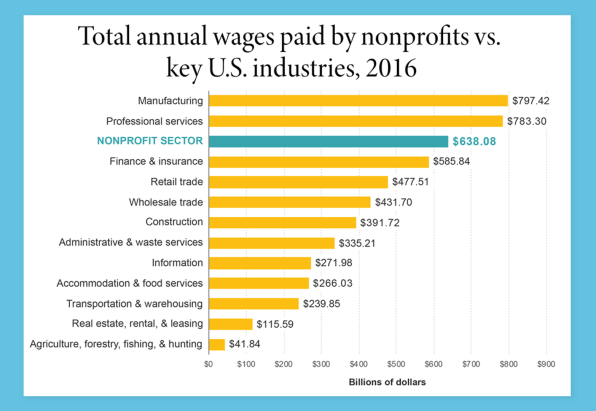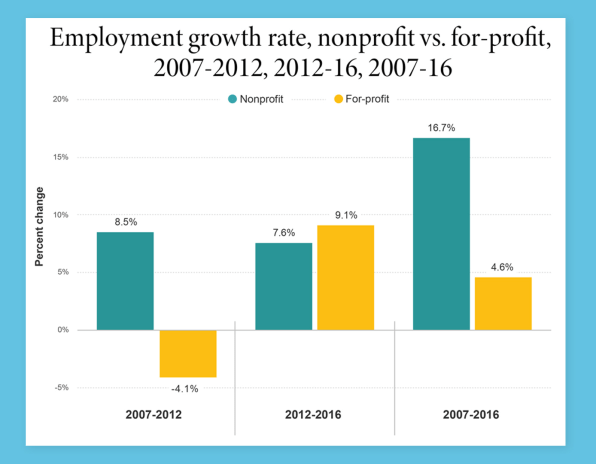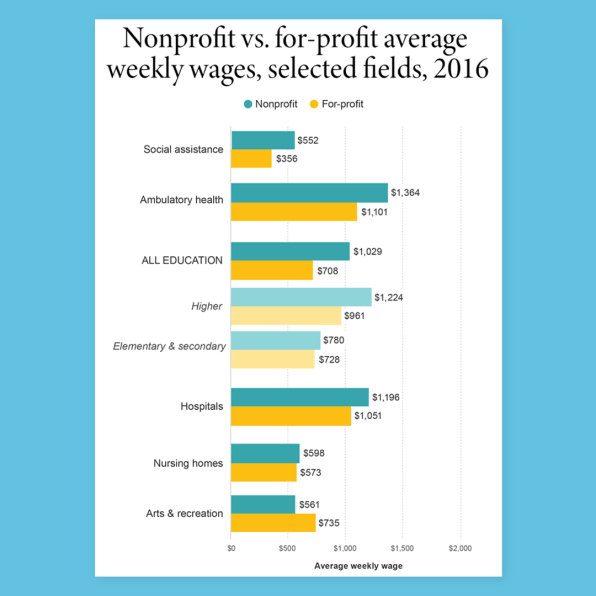
The Business of Nonprofits
Ben Paynter, Fast Company, February 13, 2019
MCF Intersection
A regular snapshot of the trends, news and research in the world of philanthropy — and its impact on business.
Connect
Nonprofits’ main goal is helping people in need, but the sector itself has grown to the point that it’s also providing a valuable service to the U.S. economy. Overall, the nonprofit sector provides roughly 10% of all private jobs in the U.S., employing more than 12 million people.
“The 2019 Nonprofit Employment Report,” an analysis by Johns Hopkins Center for Civil Society Studies, parses data from the Quarterly Census of Employment and Wages provided by the Bureau of Labor Statistics. The researchers determined that by the end of 2016, the sector came in third overall in total employment rate, tied with American manufacturing. The overall leaders in job growth are retail trade, followed by the accommodation and food service industries.

In terms of payroll, the sector comes in third again, providing more than $638 billion. The leader board changes a bit, though, with manufacturing, followed by professional services (jobs that require special training, like doctors, lawyers, or accountants) placed first and second, respectively. Either way, that represents a lot of stable jobs for people who need them.

And the sector appears to still be growing. As the report highlights, about 80% of all jobs in the sector come from three major cornerstones: healthcare (55%), educational services (14%), and social assistance (12%). But that’s complicated by the fact that more companies offering private services are now competing in the space. Over the last decade, the nonprofit employment growth rate rose roughly 16% compared to just 4% among for-profit providers offering similar services. But among those for-profits, nearly all of that growth happened over the last five years, turning around a decade in which these jobs were typically declining. In fact, between 2007 and 2016, for-profit job growth rates actually edged out nonprofits, as you can see in the chart below.

Johns Hopkins Center for Civil Society Studies director Lester Salamon, who coauthored the report, thinks this shift may be happening because companies can solicit investment instead of relying on grants, which lets them move quickly as the needs for some services change. Many programs rely on vouchers or tax expenditures, which are fair game to any kind of service provider. “We know that the population is changing, getting older, [and] that there are drug abuse problems–so the social service needs are extending into broader parts of the population,” Salamon says.
That requires expanding treatment facilities or mobilized staffers, as well as new hospitals, social service operations, and nursing homes. “All of that is producing a pretty significant demand in service fields, and for-profits seem able to really capture those,” he says. That may not be a good thing for employees. “In field after field, when you look at average wage levels, the nonprofits are much more generous to the workers than are the for-profits,” Salamon says. The report shows that nonprofit jobs pay 55% more on a weekly average than among social assistance groups, followed by 45% more in the education, and 24% more for outpatient healthcare. Hospital workers gained 14%.

There could be all sorts of reasons for that, Salamon says, including for-profits hiring part-time workers at lower wages to avoid paying benefits. They might also be lowering the qualifications for these jobs to pay people less for seemingly less-skilled work, although that might ultimately affect quality of care. “There are risks when you have dependent populations that are being served by for-profits who are not in it for the long run, who will pull out or reduce when the economy goes south, or when the reimbursement rates I get are too stiff,” he adds. “Nonprofits have a tendency to stick to it. They just ride the storm. They can reach out to their volunteers, to [people for] charitable contributions. They have proved to be incredibly resilient.”
Related Articles
Statistics
Rich Living Longer and Richer
03.20.18
Statistics
Get Rich Quick
06.27.18
Statistics
Millennial Reality Check (Part 2)
08.08.18
Statistics
Millennial Reality Check (Part 1)
08.08.18
Statistics
College, Part 2: The Need?
09.11.18
Statistics
College, Part 1: The Expense
09.11.18
Statistics
Wealthy Towns
02.28.19
